Book Reviews
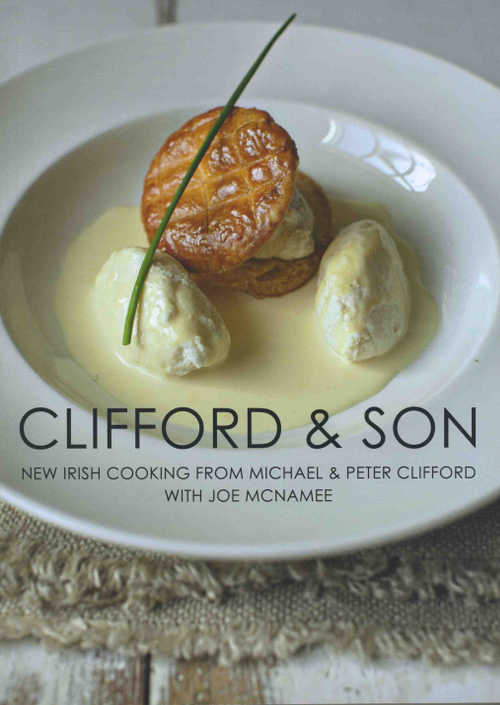 Clifford & Son, New Irish Cooking From Michael & Peter Clifford, With Joe McNamee. (Liberties Press, paperback €29.99 / £24.99)
Clifford & Son, New Irish Cooking From Michael & Peter Clifford, With Joe McNamee. (Liberties Press, paperback €29.99 / £24.99)
A warm tribute to a great chef, this is not just a cookbook but the poignant story of a quiet gentleman of the Irish culinary scene who rose from tragic childhood circumstances, that were unknown to most, to take his place as one of this country’s leading classical chefs until his untimely death in 2006 - but passed on his love of food and culinary skills to twins Peter and Laura, who were adopted by Michael and his wife Deirdre in 1993.
I remember it well as it coincided with a visit to Cork city - and, of course, to Clifford’s Restaurant - by the Irish Food Writers’ Guild, and Deirdre proudly brought their beautiful babies down to the restaurant, to present them to us for the very first time.
Both children grew up to excel in the kitchen - each has been a winner of the Tesco Young Cook Competition, for example. Peter, especially, has continued to carry the torch for his father and is now a rising star, having gone on to hone his considerable skills in many famous kitchens - and, with the help of food writer Joe McNamee (himself a trained chef) he has realised along held ambition to write a book celebrating his father’s work and introducing some of his own.
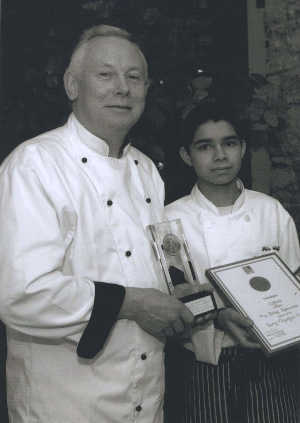 The story is mainly told by Joe, through a series of interviews conducted with many of the people who knew and admired Michael - including luminaries like Marco Pierre White, who wrote a moving Foreword.
The story is mainly told by Joe, through a series of interviews conducted with many of the people who knew and admired Michael - including luminaries like Marco Pierre White, who wrote a moving Foreword.
The recipes include an impressive collection of Michael’s classics such as his Gourmet Irish Stew, which became the definitive modern Irish Stew used by Bord Bia when showcasing ‘the food island’, his nettle soup and several dishes based on the much loved but humble local product Clonakilty black pudding - along with likeminded contemporaries, including the late Gerry Galvin, he was one of the first classical chefs to raise simple traditional ingredients like black pudding to superstar status by presenting them in fine dining dishes.
Together with Peter’s own contemporary creations, this collection comprises a touching tribute to a great father and son partnership.
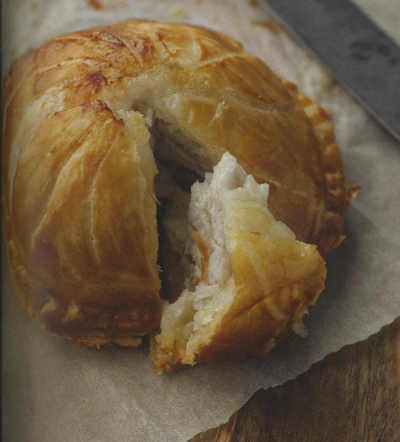 SAMPLE RECIPE: GAME PIE
SAMPLE RECIPE: GAME PIE
“This dish combined my dad's love of shooting and game. In season, he always had this one on in the restaurant. I've eaten it loads of times and I always put it on in game-season as well. This could be considered one of his fundamental recipes - a don't-leave-home-without-it recipe - and is as good as any for giving an idea of the man through his food. Use any game birds available: the more the merrier, but it's still a great dish with just one or two birds. I’ve served it with prunes macerated in port and star anise and a bit of braised red cabbage and chestnuts. I've never had the patience to wait, but I've a feeling it would also be good eaten cold as a winter picnic lunch.”
INGREDIENTS
2 shallots, sliced
1 clove garlic, crushed
2 sprigs thyme
25g butter
250g game meat, finely sliced
1 large Rooster potato, grated
280g puff-pastry sheet
125ml fresh cream
2 tbsp milk
1 egg
METHOD
Saute shallots, crushed garlic and thyme in butter. Mix with the finely sliced game meat, add grated potato and season with salt and pepper.
Line the base of a shallov baking dish with pastry, place the filling on top, cover with the rest of the pastry and secure the edges. Brush the pastry with an egg wash made by beating together the milk and egg and cut a 1 cm circular hole in the centre of the pie to act as a ‘chimney for steam.
Cook for 20 minutes at 185° Celsius. Meanwhile, reduce the cream by half. Remove the pie from the oven, pour the reduced cream into the hole, cook for a further 5 minutes and then serve.
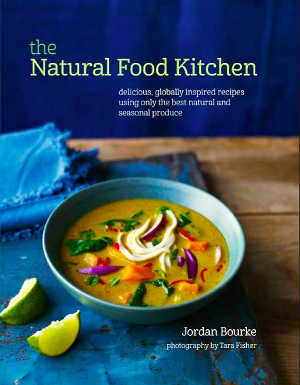 The Natural Food Kitchen, Delicious, globally inspired recipes using only the best natural and seasonal produce, by Jordan Bourke with photographs by Tara Fisher (Ryland Peters & Small, hardback160pp; £16.99).
The Natural Food Kitchen, Delicious, globally inspired recipes using only the best natural and seasonal produce, by Jordan Bourke with photographs by Tara Fisher (Ryland Peters & Small, hardback160pp; £16.99).
Jordan Bourke is based in London - where he worked with the wonderful Skye Gyngell when she was at the Petersham Nurseries restaurant, among many other starry projects - but this engaging young chef trained at Ballymaloe and is an active member of the Irish Food Writers’ Guild.
His first book, The Guilt-Free Gourmet, written with his sister Jessica, was a best seller, and now he’s back on a solo run with more exciting healthy food.
Offering up more of his signature “indulgent yet ‘guilt-free’ food”, this colourful new globally inspired collection is aimed at well travelled cooks of all ages who love their food but are health conscious too - and there will be plenty here to please even the most jaded palate, so he is sure to have another success on his hands.
SAMPLE RECIPE:
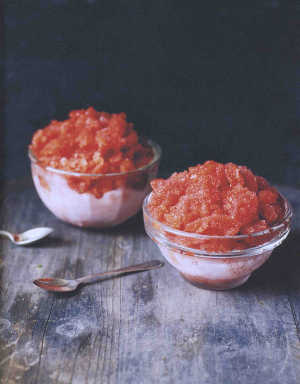 Winter granita of blood orange & persimmon
Winter granita of blood orange & persimmon
Granita is a lovely way to finish off a meal. Light and refreshing, it really showcases the natural flavours of whichever fruit you use. Here, beautiful winter blood orange and persimmon (see buying tips below), make for a perfect partnership and a really refreshing dessert.
2 very ripe 'hachiya' persimmons (flesh should be completely soft, almost falling apart)
juice of 8 blood oranges (about 550 ml/2¼ cups)
zest of 1 unwaxed lemon
6 tablespoons pure maple syrup
pinch of sea salt
Serves 4-6
Cut the persimmons in half and scoop out their gelatinous, almost liquid flesh. Place in a food processor with the blood orange juice, lemon zest, maple syrup and salt. Blitz on and off until the persimmon flesh is puréed and everything is well combined.
Transfer the liquid to a shallow tray, preferably metal, and carefully place it in the freezer. After 1 hour, using a fork, drag the ice crystals away from the edges. Do not whisk it all up as you would with a sorbet, as you want to keep the large crystals of ice intact.
Place it back in the freezer for a further 2 hours to set properly. When ready to serve, remove from the freezer and scrape with a fork until rough; this will take a bit of effort, as the granita will be fully set.
Spoon into chilled glasses and serve.
PERSIMMON TIPS
They look quite similar, but have completely different textures and uses. Confusingly, the hachiya and fuyu varieties will often be sold under one general name, either persimmon, Sharon fruit or cachi, but really it is their specific name that is most important, so be sure to ask if you are unsure.
Round and larger than fuyu, hachiya is astringent, extremely tart and very firm when unripe, so don't attempt to eat them then. During ripening, they will go from orange to a very deep orange, almost red colour, and their flesh will become completely soft, almost exploding out from their skin, and gelatinous once opened.
Fuyu are smaller and squatter in shape, and are often sold in the UK as Sharon fruit. They remain quite firm on the outside, with a slightly softer, yet still slightly crunchy inside. With a mild sweetness, they are ideal for eating as you would an apple.
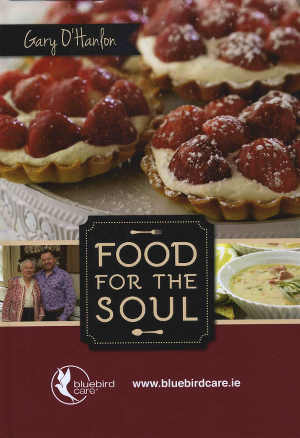 Food For The Soul by Gary O’Hanlon (Bluebird Care, hardback 144pp RRP €19.95)
Food For The Soul by Gary O’Hanlon (Bluebird Care, hardback 144pp RRP €19.95)
Perhaps best known these days as known as head chef of the superb Longford restaurant VM at Viewmount House, Gary O’Hanlon is also a proud Donegal man so it’s very appropriate that his first cookbook, Food for the Soul, was launched at A Taste of Donegal Food Festival in August.
Gary partnered with Bluebird Care (www.bluebirdcare.ie) on the project and Operations Director, Eddie O’Toole, said that “good home cooking is very important to our customers who live in their own homes …and we understand the importance of a healthy and balanced diet.”
Describing the book as ‘food for the soul, stories from the heart’ Gary has selected a range of recipes for all abilities and most occasions, from Starters and Snacks to Mains and Desserts.
He has personalised each recipe with background information and reminiscences - and, as well as giving a ‘How-to-Guide’ for the more difficult recipes, there’s even a series of online videos showing Gary cooking each dish.
A book with heart, that is going to raise money for Active Retirement Associations across Ireland, this is a great initiative and very worthy of support.
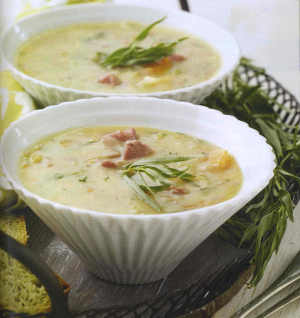 SAMPLE RECIPE: HAM HOCK & SPLIT PEA BROTH
SAMPLE RECIPE: HAM HOCK & SPLIT PEA BROTH
This hearty budget-friendly recipe would be great for feeding a crowd, but Gary says that it also freezes well - wouldn’t it be very handy to have some in the freezer over Christmas and New Year?
SERVES 15-20
Ingredients
2 ham hocks (soaked in cold water for 24 hours)
1 large onion finely chopped
l00g barley soaked in cold water for 2 hours
l00g green split peas
100g yellow split peas
3 carrots diced
4 stalks of celery, peeled then diced
5 litres chicken stock
1 lb butter
2 cups flour
White pepper and salt to taste
Boil the ham hocks for 3 hours or until the meat is falling from the bone.
Set aside.
Melt the butter and add the carrots, onion, celery, peas and barley.
Cook for 5 minutes, stirring every minute.
Add the flour to make a roux.
Mix well, but gently.
Now add the chicken stock.
Mix well and turn down to a very low heat.
Keep mixing every 5 minutes for 1 hour, or until vegetables etc. are cooked.
Adjust consistency if it gets a little thick, then season.
Rip off chunks of the ham hock and drop into the broth.
Will make approximately 15-20 bowls.
TOP TIPS
You could replace the ham hock with chicken by boiling a whole chicken, using the stock for the broth then ripping up the meat and dropping into the broth.
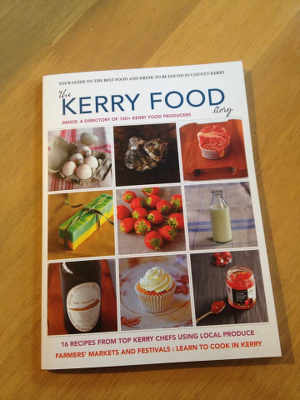 The Kerry Food Story (Published by the Institute of Technology, Tralee, Co. Kerry, 68pp paperback. Supported by Kerry Local Enterprise Office; free of charge)
The Kerry Food Story (Published by the Institute of Technology, Tralee, Co. Kerry, 68pp paperback. Supported by Kerry Local Enterprise Office; free of charge)
Well they say that the best things in life are free and, while contradictions abound, The Kerry Food Story seems to back up the theory. It’s a great little booklet for anyone - interested visitor, local retailer or customer, hotelier, chef or student - who wants to reference the 150+ Kerry food producers listed in the directory, and there’s no shortage of inspiration in the recipes supplied by eight of the county’s top chefs, all of whom have studied at the IT Tralee.
You’ll also find a list of cookery schools, information on farmers' markets and festivals where you can buy produce and useful Kerry websites to find out everything about local food and drink in the region.
Creating recipes especially for the project, chefs have showcased a wide range of ingredients to demonstrate the diversity of local products, including local fish and seafood such as Kush Mussels, Beaufort Free-Range Eggs, Annascaul Black Pudding, Ballinskelligs Duck, Ring of Kerry Lamb, Valentia Island Milk and Farmhouse Ice Cream, indulgences like Lorge and Skelligs Chocolates - and the relatively new Dingle Gin.
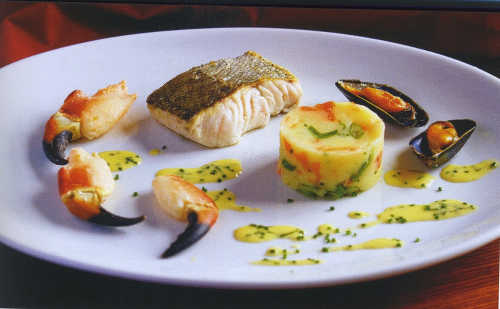 SAMPLE RECIPE: Fillet Of Portmagee Pier Hake with Daly's Smoked Salmon, Cromane Mussels and Skellig Crab Claws
SAMPLE RECIPE: Fillet Of Portmagee Pier Hake with Daly's Smoked Salmon, Cromane Mussels and Skellig Crab Claws
From Noel Dennehy. Head Chef at The Moorings, Portmagee.
4 x 200g Portmagee hake fillets
Sea salt
2 tablespoons olive oil
j 80g Daly's smoked salmon
3 spring onions
320g hot mashed potato
20 fresh Cromane mussels
1 tablespoon of butter
1 shallot, finely chopped
1 clove garlic, finely chopped
50 ml white wine
100ml cream
Juice of 1/2 lemon
1 tablespoon chives, finely chopped
12 Skellig Crab Claws
1. Preheat the oven to 180C/350F/Gas 4. Season the hake with sea salt. Heat a tablespoon of olive oil in a non-stick frying pan with an oven-proof handle. Add the hake, skin-side down first, and fry for 1 minute. Turn the fish over gently, then cook for 1 minute more before placing the pan in the oven for five minutes.
2. Slice the smoked salmon and spring onion finely and stir into the hot mashed potato. Keep warm.
3. Sauté the mussels in a tablespoon of butter with the shallot and garlic for 1 minute. Add the white wine and reduce by half. Add the cream and cook for 1 minute. Add the lemon juice and chives and stir. Add the cooked crab claws and cook for 1-2 minutes until heated through.
4. Divide the potato between four warm plates. On each plate, place a fillet of hake with 3 crab claws and 5 mussels. Drizzle any sauce from the pan around the fish and serve immediately.





There are currently no comments
Leave a comment
Not a member? Register for your free membership now!
Or leave a comment by logging in with: